The intent of this article is to explain goldfish coloration and why your goldfish might be going through significant color changes as time goes by.
For example, did you buy a goldfish with inky black patches only to watch them slowly recede to orange? Or maybe you’ve had a nice red and white goldfish, but in time the red has gradually disappeared? Well, this article is for you.
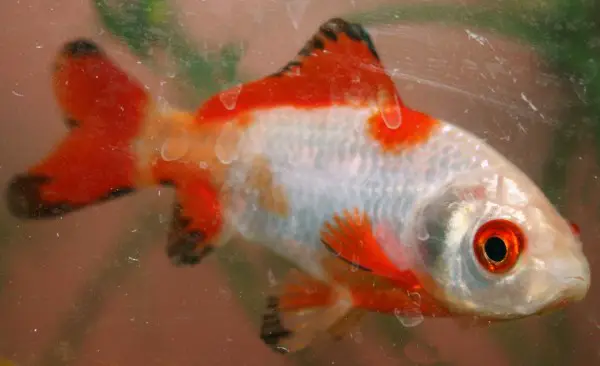
https://commons.wikimedia.org/w/index.php?curid=10177598
Red, white, and black goldfish. The black is in the process of fading and leaving red behind.
Let’s start by putting your fears to rest. Goldfish changing color as they mature is almost always perfectly normal.
For the last 30 years I’ve kept goldfish on and off, and I can’t tell you how many times I’ve watched goldfish turn from black to orange and then orange to white. And let me just reaffirm that opening point: in all those years, I’ve never had a fish change color as a result of ill health. Transformations in color have always been a natural pigment change as the fish matured.
If you’re like me, and you love goldfish, you’ll find the underlying science fascinating.
Wild Ancestors And Goldfish Coloration
Goldfish were bred from a wild species of carp. The goldfish’s closest known relative is the Prussian carp (Carassius gibelio).
For those of you familiar with the greenish brown color of wild carp you might be wondering how bright orange, yellows, reds, and whites come from wild types of carp. This becomes clear when we understand what produces the greenish brown color of Prussian carp; its natural coloration is comprised of black, white, red, and yellow.
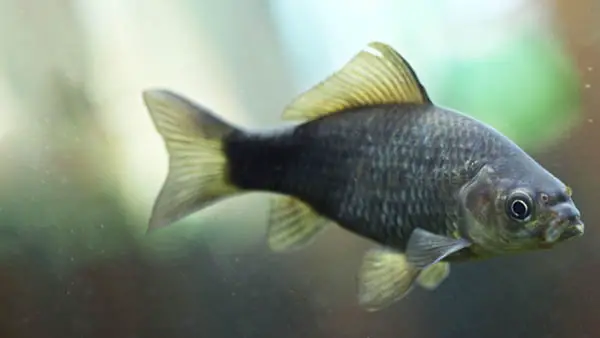
In Ancient China, the ancestors of domestic goldfish were farmed for food. It was from that food stock that mutations occurred, i.e. some of the offspring appeared more orange than brown as a result of a reduction in, or complete lack of, black pigment.
These colorful carp were separated from the food stock and prized as ornamental fish. After which, goldfish were selectively bred. And the rest is piscine history.
Scale Types And The Goldfish Palette
A fundamental part of the minutia of goldfish coloration is the relationship between color and scale type.

Goldfish have three types of scale: metallic, nacreous, and matte. Metallic goldfish, as the name suggests, have a metallic shine to their scales. Nacreous goldfish come in a calico color form, and their scales have a pearlescent value that resembles mother-of-pearl, while matte scales are transparent and therefore show a flat color akin to matte paint.
Metallic Scales
Metallic scaled goldfish are the most common you’ll come across in your local fish store, so I’ll talk about them first.
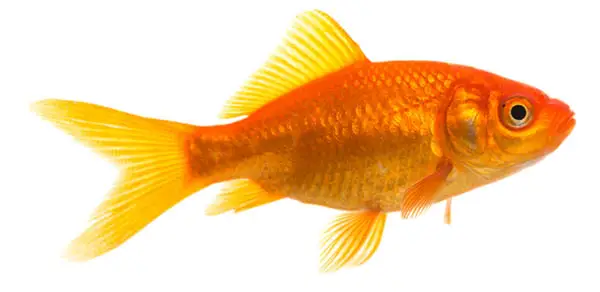
Most fish, not just goldfish, possess very shiny scales. This is because the scales have an underlying layer of a compound called guanine.
What Is Guanine?
Guanine gets its name from “guano”. The reason for this is that guanine is also present in bird droppings, and guano is a term used for the layer of droppings found wherever birds or bats roost.
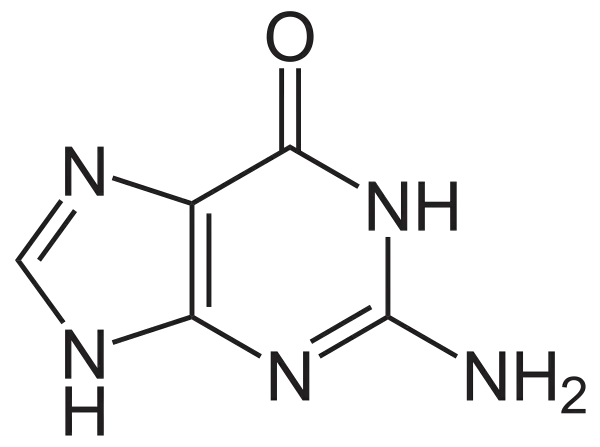
However, the guanine found in fish differs from that found in bird feces; it is thin and crystalline. This is important because it being crystalline in form is what causes it to refract light, and that refraction is what causes the fish to look metallic or shiny.

Guanine And Color
So how does guanine affect the color of your goldfish. Well, because it makes the scales appear “solid” in color. The best way to explain this is to make a comparison with a matte scaled fish. Matte scaled goldfish can appear pinkish, because the transparent scales allow the flesh beneath to color the fish. Whereas, metallic scales will hide what’s going on underneath and instead the overlying pigment will color the fish.
Color And Chromatophores
That brings us nicely to pigment in goldfish. As we mentioned earlier, goldfish are dealing with the genetics their ancestors gave them. So, when it comes to color, we’re talking about white, black, orange, and yellow.
Color in fish is controlled by chromatophores. These are pigmented cells that reflect light and thereby cause the colors we see in fish (and other animals).
Interestingly, the guanine responsible for making goldfish appear metallic is created by a type of chromatophore. Guanine is deposited by iridophores. Without other chromatophores, and thereby, pigments, to color the goldfish, it will appear white with a metallic sheen.
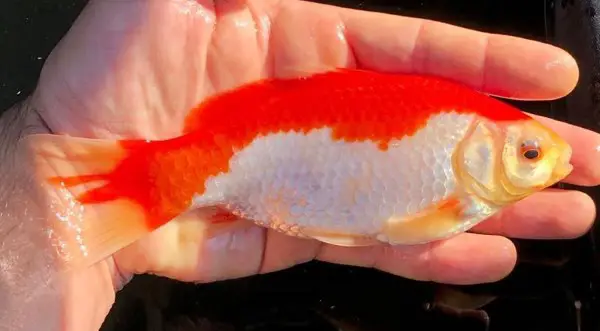
Other chromatophores at play are xanthophores (yellow), erythrophores (red), and melanophores (black).
Since most goldfish are orange, the coloration they display comes from a combination of yellow and red. Sometimes a goldfish can have patches of orange (which can be more yellow or more red) on a white background. More intense reds are possible when combined with large areas of white on a goldfish.
When goldfish look very red, the yellow is still present, but it is more subdued. And vice versa, a yellow goldfish will still have a modicum of red in its pigment.
Loss of Red, Yellow, or Orange In Goldfish
So, what happens in a metallic goldfish when it loses a little, or a lot, of its orange coloration? Well, the pigments responsible for the color are destroyed. As the yellow/orange/red color recedes, it leaves behind the metallic white of the guanine.
There are a number of possible explanations for the loss of color in goldfish.
Sunlight
Goldfish keepers have observed that ample sunlight enhances red coloration. If you’ve ever bought a nice red and white goldfish from the pet store, only to slowly watch the red fade to orange in your tank at home, this is because of its change of environment.
Ornamental fish are typically raised in outdoor ponds, goldfish included. So when your red and white goldfish arrived in the fish store’s tanks, it had a nice red color.
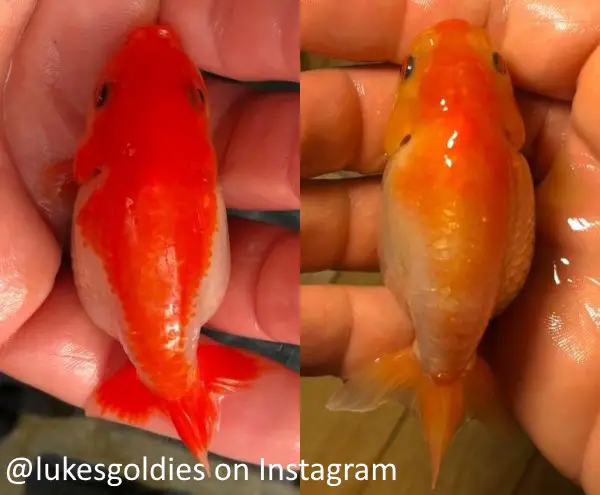
However, if you have a genetically more orange or yellow goldfish and put it in an outdoor pond, it won’t turn red. The necessary genetic component has to be there for it to show a scarlet red color.
While I believe sunlight can enhance existing reds, I am not convinced that a lack of it can cause a fish to turn white. I concede that limiting natural light can cause reds to fade to orange, but some believe lack of sun can cause red/yellow/orange to recede entirely.
Diet
Modern commercial foods contain color enhancers. Therefore, the difference in the intensity of red between indoor and outdoor kept goldfish isn’t as pronounced as it was in the past. However, the opportunity to forage in an outdoor setting cannot be understated. The intensification of red under a diet of pigment rich invertebrates, algae, and plant life is profound.
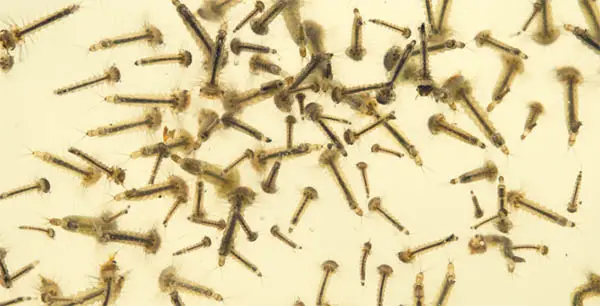
Combine a great diet with the benefits of sunlight mentioned above and you might just have yourself a blood red goldfish!
Some fishkeepers believe that poor diet can cause a goldfish to lose yellow/red/orange entirely and turn white. I concede that this could be possible, but I am not totally behind this. Although, it follows logic that without the components in the diet to create a particular color, the fish might then lose that color. Although, I find it unlikely that a domestic goldfish is short on the necessary color enhancers (because commercial fish foods are full of color enhancing ingredients).
Genetics
This is the one for me. I’m happy to concede that diet and environment might be triggers for color change. But, I believe loss of orange in goldfish is something the fish inherits from its parents.
So, if you really like that red and white pattern on a juvenile goldfish, be aware that the pattern can change completely as the fish ages.
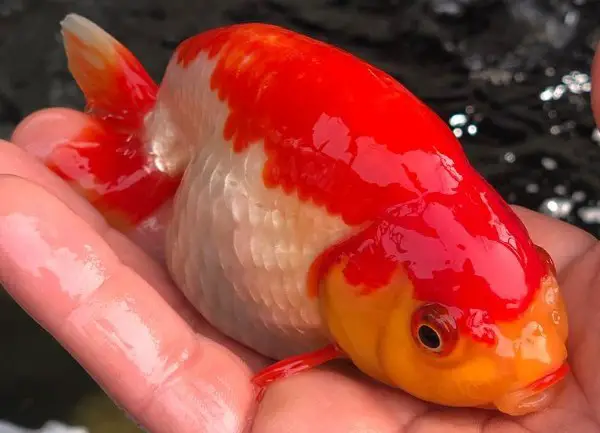
If you want to have a safer roll of the dice, then purchase your goldfish directly from breeders, as they can tell you how stable the color was in the parents, and therefore, how likely the color will be stable in the offspring.
You Bought A Black And Orange Goldfish And It’s Losing Its Black?
I got my first black and orange goldfish when I was 9 years old. I named him Scorpion. And I was quite disappointed when the fish quickly lost the black that ran from his nose, along his back, and onto hiscaudal fin.
With goldfish color development, it’s important to understand what happens with goldfish fry (i.e. baby goldfish). When they are very young they have a color similar to their wild ancestors, a greenish/brownish sort of color.
Before goldfish get their brighter, more desirable coloration, they go through a period of demelanization. Which means they lose their black pigments. But, before this happens, the fish will often darken first, and many times a young goldfish will take on an inky black color.

However, that inky blackness will fade to yellow, orange, red, or white eventually in all but a few strains of goldfish. There’s nothing you can do to stop this, so appreciate the fleeting beauty of that striking black while you can.
As with a loss of yellow/red/orange to white, a loss of black in goldfish is perfectly natural and nothing to worry about; it is not an indicator of poor health.
But I Really Want A Black Goldfish!!!
Black in goldfish is historically unstable, i.e. it fades as mentioned above. Having said that, there are a few exceptions where black can be maintained.
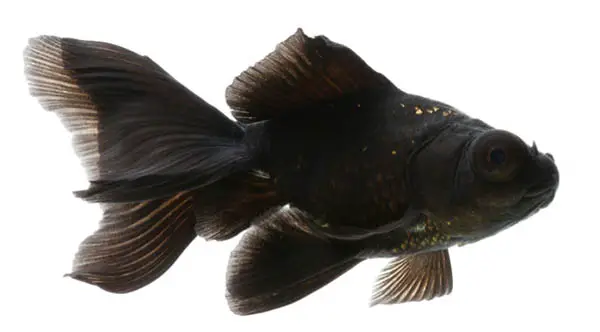
Probably the most well known black goldfish is the “black moor”, a twin tailed goldfish with telescope eyes. The telescope eye mutation is strongly associated with the failure of demelanization, i.e. the black does not fade to orange.
Black, although not as intense, can be maintained in some other fancy breeds such as the oranda, ranchu, lionhead, pearlscale, and the bubble eye.
Special Mention: Blackout Comet
And a final modern example of a stable black in a goldfish is the “blackout comet”. This is a single tailed fish with a solid black coloration that does not fade to orange or white over time.
The origin of the blackout comet is disputed, as is often the case with newly produced ornamental fish. This is because the farm responsible for creating new and desirable fish want to protect their secrets so others can not reproduce their fish and thereby prices stay high.
It has been surmised, though, that breeders stabilized black via the introduction of another species (hybridization). Some believe a species of carp, possibly koi, was crossed with goldfish in order to create a black “goldfish”.
Nacreous Scales
Nacreous is an interesting word, it comes from the word nacre, which means mother-of-pearl. So, goldfish with nacreous scales have an aesthetic that resembles mother-of-pearl.
Guanine is distributed unevenly in nacreous goldfish. This results in some scales having a full compliment of guanine and appearing fully metallic, while others have a partial reflectivity from which fishkeepers made the connection with mother-of-pearl.
Nacreous scaled goldfish are a curious case because they go hand-in-hand with a unique color type: calico. Goldfish with a calico pattern are still working with the same colors (black, red, yellow, white). The difference is in how those colors are distributed; they tend to be spread out in patches, and black in calico goldfish is typically speckled. Also worth noting is that black is very stable in calico goldfish.
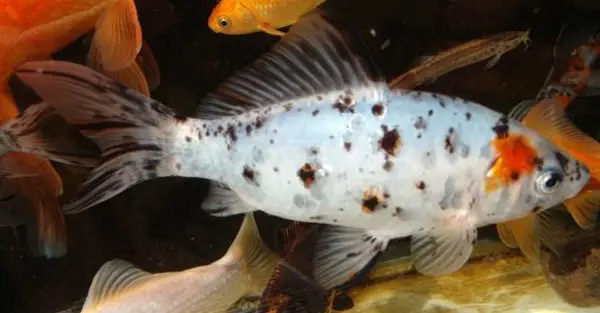
As if calicos weren’t interesting enough to begin with, they generally have a sky blue base upon which their reds, oranges, and blacks occur. This blue color actually comes from latent black pigment which appears blue to our eyes.
Any goldfish variety can come in a calico form. But, when the goldfish has a single tail, we call it a shubunkin.
Color Changes In Calico Goldfish
Like metallic goldfish, diet and environment certainly play their part. You are able to intensify any present red with the right food and access to good light.
If you find your calico goldfish is getting duller and taking on a “washed out” kind of look it could be that your aquarium or pond is too lightly colored.
The best way to explain this is with an anecdote of my own.
I had setup a tank for breeding discus (a type of cichlid fish). Discus tanks are often given white backgrounds for breeding purposes. So I painted the back of the tank white.

Later on, I repurposed that tank for goldfish. I watched as a shubunkin’s colors drained away on the light background. I supposed that the fish was adapting to its light backdrop. So, I moved the fish to a tank with a black background, and lo and behold, the shubunkin’s colors deepened, darkened, and intensified again.
Matte Scales
The final scale type to discuss is matte. And I wish I could say I’d saved the best one for last, but sadly, I had no such foresight.
Matte scaled goldfish are the least desirable type of goldfish, so much so that most casual fishkeepers will probably never have seen one for sale in a fish store’s tanks.
Breeders typically cull matte scaled goldfish at an early stage. This is because they generally possess weak or no coloration at all.
Their scales have no guanine and therefore reflect no light. Instead, the scales are transparent and allow the pinkish color of the flesh below to show through. This pink color has given rise to the nickname, “pinkies”.
Buy Good Food!
Sure, you need good genetics and solid water quality. But, you cannot underplay the importance of good food in bringing out the color in your fish. Check out my article here on some of my favorite fish foods.




